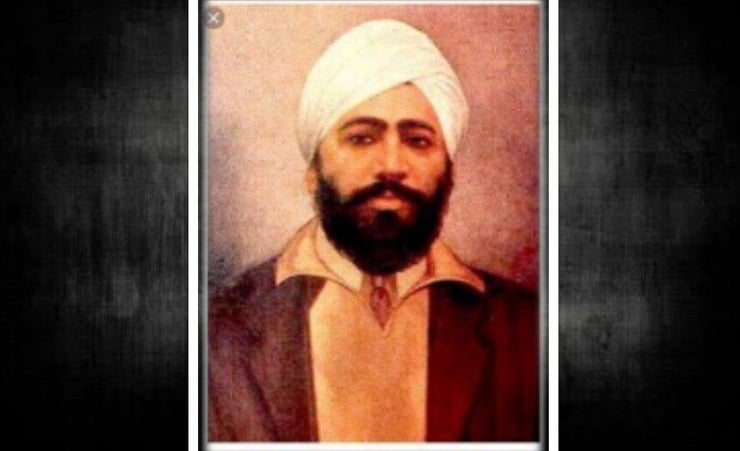Remembering Shaheed Udham Singh: The revolutionary who avenged Jallianwala Bagh Massacre

December 26 marks the birth anniversary of Shaheed Udham Singh – a revolutionary who avenged the horrific Jallianwala Bagh Massacre of 1919.
Udham Singh Kamboj was born on 26 December 1899 at Sunam in the Sangrur district of Punjab. He was born as Sher Singh Kamboj, named so by his parents, and had an elder brother, Mukta Singh. His mother was Narain Kaur and father Tahal Singh Kamboj. He worked as a watchman on a railway crossing in the neighbouring village known as Upall.
Early years and impact of British colonialism
Udham Singh’s parents passed away early. His mother died in 1901, and his father in 1907, when he was about seven years old. On 24 October 1907, Udham Singh along with his brother moved to an orphanage, known as Central Khalsa Orphanage in Amritsar. Somehow for some reason, their names were changed during that time – from Sher Singh he became Udham Singh and his brother from Mukta Singh to Sadhu Singh. Udham Singh was considered to be very intelligent, and he got trained in various arts and crafts during his time at the orphanage. He was good in music, painting and later on from his biography we also come to know that he was a good writer and always maintained a diary.
In 1917, Udham Singh was 18 years old when his brother Mukta Singh died, reportedly killed during the British suppression of the Amritsar riots. The loss of his brother came as a big shock to Udham Singh: he was left alone in the world. The following year, he cleared his high school exams and moved out of the orphanage.
During the years 1918 to 1919, resentment had started building up against the British. The First World War forced contribution to the war service and the ruthless recruitment of the soldiers had opened the minds of the people to new ideas about the draconian colonial rule.
During the war, the British treatment was painful in many ways. Indians were treated as slaves, paid less than their white counterparts and segregated in camps and ships. When the few surviving Indian soldiers, returned home after the war and saw how the British had impoverished India, it aroused deep resentment in them.
The arrest of senior freedom fighters Dr Satyapal and Saifuddin Kitchlew under the Rowlatt Act of 1919 was also met with widespread anger and discontent among the people of Punjab. Their supporters had gathered in front of the police station to protest and demanded to know the whereabouts of them. On the order of one Miles Irving, these supporters were shot at in which 20 to 25 people were killed and injured.
Jalianwala Bagh massacre
It is said that a British female doctor had laughed at the wounded Indians in the hospital, who were bleeding to death from the bullets of Miles Irving. To punish this doctor for her heartlessness, an irate mob dragged a missionary school-teacher and beat her savagely, mistaking her for the doctor. This incident sparked violent riots between civilians and the British. The enraged crowd armed with long sticks (lathis) had started moving toward government properties, burning and looting them. Post offices, railway stations were set alight. In this frenzy, a British bank manager was bludgeoned to death, and his body was burnt along with his furniture.
The British were shaken up by the mobs and their attacks. General Reginald Edward Dyer in the region believed that the time had come for the people of Punjab to know and to be reminded who was in charge of Punjab.
On 13 April 1919, a large public meeting was called at the Jallianwalla Bagh by a group of nationalists. The agenda was to discuss the arrest of Dr Satyapal and Dr Saifuddin Kitchlew. At around 4:30 pm, 20,000 unarmed protesters mostly from surrounding villages had crammed in there. The innocent people had mainly come to visit the Golden Temple and to celebrate Baisakhi with their families. They were unaware of the happenings of the past and had peacefully assembled at Jallianwala Bagh to listen to the prominent local leaders speak out against British colonial rule in India.
Brigadier General Reginald Dyer who was in charge of Amritsar marched toward the Bagh with 150 men from the Gurkha regiment. The protesters and the women with their children were in the open ground, which was enclosed by walls on all sides and had only one narrow exit. Without giving any warning to the unarmed people and shutting the only narrow exit of the Bagh with the armoured car mounted with a machine gun and he ordered his men to start firing at the trapped unarmed civilians. The firing lasted for eight to ten minutes in which many died from bullet wounds while others died when they jumped into the well to save themselves, only to be crushed by those who desperately dived on top of them. A total of 120 bodies were retrieved from the well, and the ground was strewn with the dead bodies of women, small children and young men.
The entrance of the Jallianwala Bagh was closed for 24 hours after the shooting. The wounded could not be moved as a curfew had been declared, and this resulted in a total death toll of 1800. Wounded men, women and children were left there for hours to die without even a drop of water given to them. And the people who were outside the Bagh were forced to crawl on their bellies in the narrow streets of Amritsar. Anyone who dared to lift their head was attacked. The actual figure of dead people in the Bagh was never fully ascertained, an official British investigation at that time put the number of people dead at Jallianwala Bagh to only 349, but Indians insisted that the figure was closer to thousands of people including young children.
Becoming a revolutionary
Udham Singh was serving water to the thirsty, innocent crowd on that fateful warm summer afternoon at the Jallianwala Bagh. He was 20 years old and was deeply scarred by the Jallianwala Bagh massacre. He somehow survived the attack, which massively impacted him and turned him to the path of revolution. He started planning his way to take revenge for the massacre of Jallianwala Bagh and thus plunged into active politics and became a dedicated revolutionary.
The first time when Udham Singh left India was in 1920 to East Africa. There he worked as a labourer for the railway lines and made his way to New York. In 1924 he reached the United States and came into contact with the Ghadar Party and joined them.
Bhagat Singh deeply influenced Udham Singh, and on his order, he returned to Punjab in 1927. Due to his links with Ghadar party and Bhagat Singh, he was under constant police surveillance and was arrested on 30 August 1927 in Amritsar. He was found in possession of one unlicensed pistol, two revolvers and a banned Ghadar Party newspaper called Ghadr Di Gunj and was thus convicted and sentenced for five years in Multan Jail.
Udham Singh was very fond of reading. During his time jail he had a copy of Waris Shah Heer with him and would love to recite lines to the people around him. He loved writing and always maintained diary. In 1931 the news came to Udham Singh in the jail that, Bhagat Singh, Rajguru and Sukhdev are hanged. This heartbreaking news further strengthened his resolve to assassinate General Dyer.
In 1931, General Dyer’s untimely death due to natural causes failed to assuage the feelings of Udham Singh. He then made Michael O’ Dwyer his target and started planning to go to London and assassinate him. Michael O’ Dwyer was the Lieutenant Governor of Punjab during the time of the massacre and had defended Dyer’s actions for the Jallianwala Bagh massacre. O’Dwyer had vigorously supported Dyer not only in front of Hunter Commission but also later in England describing him as “Quite correct” under the circumstances and rewarding him handsomely for his actions.
Udham Singh’s jail term ended on 23rd October 1931. Once out, due to his links with Bhagat Singh’s Hindustan Socialist Republican Association, he was always under police surveillance. However, he managed to escape to Kashmir in 1933 and from there managed to finally reach London the following year via Germany, France, Switzerland and Austria.
In London, Udham Singh took up residence at 9 Alder Street, Whitechapel (East London) near Commercial Road. There he bought a car and a six chamber revolver. He also joined the Indian Workers Association, a socialist organisation in London. He did many odd jobs in London and also worked as an extra in two movies called Elephant Boy (1937) and The Four Feathers (1939). Udham Singh kept changing addresses and did all kinds of odd jobs under different names like Sher Singh, Ude Singh and Frank Brazil.

His real objective, however, always remained to assassinate O’Dwyer. Udham Singh came to know about O’Dwyer’s whereabouts and watched him taking a morning walk, but he did not attempt to kill O’Dwyer then and there. So despite numerous opportunities to strike Michael O’Dwyer Udham Singh waited for the right moment where he could make more impact with the killing and attract global attention to his cause.
On 13 March 1940 in London’s Caxton Hall, a meeting of East India Association and the Central Asia Society was to be held, where Michael O’Dwyer was to speak. Udham Singh sneaked into the hall with the revolver hidden in his book, which was specially cut for the purpose to conceal it. He took an empty seat against the wall. As Michael O’Dwyer was going toward the speaking platform, Udham Singh, who was there with his revolver waiting for the right moment, rose from his seat and fired all his bullets toward O’Dwyer. One of the bullets passed through O’Dwyer’s heart and the right lung, killing him immediately.
During the shooting, Sir Louis Dane, Charles Cochrane Baillie Lamington and Lord Zetland also got injured. Udham Singh wanted to kill Zetland but was unsuccessful as on his arrest Udham Singh did ask if Zetland is dead. Zetland was a Secretary of State of India Affairs in 1919 at the time of Jallianwala Bagh massacre and had killed many innocent people in Punjab. After the shootout, people had started running out of the hall. Udham Singh did not make any attempt to run from Caxton Hall. Instead, he stayed there and boldly raised slogans, Inquilab Zindabad for the freedom of India and waited to be arrested.
Trial, hunger strike in prison & hanging
Udham Singh’s trial for murdering O’Dwyer started on 1 April 1940. V.K. Krishna Menon and St John Hutchison represented Udham Singh’s case before Justice Atkinson. During his trial, Udham Singh made it very clear that he was not guilty of killing O’Dwyer and had waited for 21 years to take the revenge of Jallianwala Bagh. When asked, he gave his name as Ram Mohamed Singh Azad as a symbol of Hindu Muslim and Sikh unity in the fight for India’s Freedom.

(Photograph of Udham Singh being escorted from the Caxton hall by police.
Udham Singh smiling broadly, as if from the satisfaction of a mission accomplished).
While waiting for his trial in Brixton Prison, Udham Singh went on a hunger strike for 42 days and forcibly fed through a tube. Why Udham Singh did that, was never clear as British Government made strenuous attempts to muzzle up all the information regarding him. The British confiscated Udham Singh's diary and other belongings. Also, the statement that he read at his trial was directed by the Judge not to be released to the press.
Finally, Udham Singh was convicted of murder and sentenced to death on 31 of July 1940. He was hanged at sharp 9 am at Pentonville Prison, and his body was buried in a small burial ground next to other prisoners.
After that, Udham Singh was known as Shaheed- e- Azam Sardar Udham Singh and inspired many young Indians to fight against British atrocities with an aim to free India from their oppressive rule. On his birth anniversary, we salute this man, a revolutionary, freedom fighter who made the supreme sacrifice by giving his own life for the love of his country.




